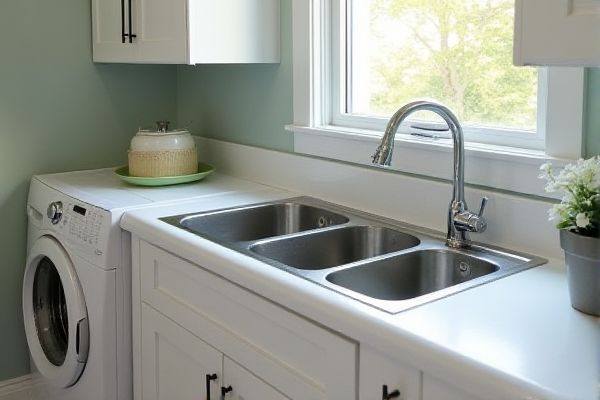
A deep utility sink offers more capacity for soaking and scrubbing large or bulky items, while a shallow laundry sink is ideal for quick rinses and space-saving installations. Explore the rest of the article to determine which sink suits your laundry needs best.
Table of Comparison
| Feature | Deep Utility Sink | Shallow Laundry Sink |
|---|---|---|
| Depth | 10-16 inches | 5-8 inches |
| Capacity | High, suitable for large items | Low to moderate, best for small laundry tasks |
| Material | Stainless steel, cast iron, or heavy-duty plastic | Porcelain, plastic, or lightweight materials |
| Ideal Use | Heavy-duty cleaning, soaking large items, utility tasks | Light laundry tasks, rinsing clothes, small cleanups |
| Installation | Freestanding or wall-mounted | Wall-mounted or integrated with laundry area |
| Cost | Higher due to size and materials | Lower, more affordable |
| Space Requirement | Requires more space | Compact, saves space |
| Drainage | Large drain for faster water flow | Standard drain, suited for lighter use |
Deep Utility Sink vs Shallow Laundry Sink: A Comprehensive Comparison
Deep utility sinks offer increased capacity and depth, making them ideal for handling large, heavy-duty tasks like soaking tools or washing bulky items. Shallow laundry sinks provide easier access and quicker drainage, suitable for light washing or rinsing needs, saving space in smaller laundry areas. Choosing the right sink depends on your specific tasks and space requirements to optimize your laundry workflow.
Key Differences Between Deep and Shallow Sinks
Deep utility sinks offer greater capacity and depth, making them ideal for washing large items, soaking heavily soiled clothes, or handling messy tasks without splashing water outside the basin. Shallow laundry sinks provide easier access and quicker drainage, suited for lighter tasks such as rinsing or handwashing delicate fabrics, where less water volume is needed. Choosing your sink depends on the task intensity and available space, with deep sinks catering to rugged use and shallow sinks enhancing convenience.
Benefits of Choosing a Deep Utility Sink
A deep utility sink provides superior capacity and versatility for heavy-duty cleaning tasks, accommodating large items such as mop buckets, gardening tools, and bulky clothing. Its increased depth minimizes water splashing and enhances convenience when soaking or scrubbing, making it ideal for laundry rooms, workshops, and garages. Enhanced durability and resistance to stains and scratches further contribute to the practicality and long-term value of deep utility sinks.
Advantages of a Shallow Laundry Sink
A shallow laundry sink offers greater ergonomic comfort by reducing the need to bend deeply, which minimizes back strain during extended use. Its compact design allows for easier installation in smaller laundry rooms while providing sufficient space for tasks like handwashing delicate clothes or pre-treating stains. The shallow depth also speeds up water drainage and makes cleaning the sink more convenient, enhancing overall laundry efficiency.
Space Considerations: Which Sink Fits Best?
Deep utility sinks offer ample capacity for washing large items or handling bulky cleaning tasks, making them ideal for spacious laundry rooms or utility areas with enough vertical clearance. Shallow laundry sinks are better suited for smaller spaces or wall-mounted installations, providing practical functionality without overwhelming tight quarters. Choosing between the two depends on the available room size, ceiling height, and intended use, ensuring optimal space utilization and user convenience.
Cleaning Efficiency: Deep vs Shallow Sinks
Deep utility sinks offer superior cleaning efficiency by accommodating larger items and providing ample space for scrubbing and soaking, reducing water splashes and mess. Shallow laundry sinks are more suitable for quick rinses or small loads but limit the ability to handle bulky or heavily soiled items efficiently. The depth of a sink directly influences water capacity and usability, making deep sinks the preferred choice for intensive cleaning tasks.
Durability and Material Choices for Both Sink Types
Deep utility sinks are typically made from heavy-duty materials like cast iron, stainless steel, or thick polypropylene, providing superior durability for heavy use and resistance to stains and scratches. Shallow laundry sinks often use lighter materials such as acrylic, porcelain, or thinner plastic composites, prioritizing ease of installation and cost-efficiency but offering less long-term durability. Material choices directly impact sink longevity, with deep utility sinks favoring robust construction to withstand rigorous tasks, while shallow laundry sinks balance aesthetics and moderate functionality.
Installation Requirements and Challenges
Deep utility sinks demand more robust installation due to their larger size and weight, often requiring reinforced cabinetry or wall supports to prevent structural damage. Shallow laundry sinks, conversely, are easier to install with minimal reinforcement needs and fit well in compact laundry spaces. Your choice impacts plumbing hookups, with deep sinks typically needing deeper drain connections and more precise water line placement to accommodate greater water volume.
Cost Comparison: Deep Utility Sink vs Shallow Laundry Sink
Deep utility sinks typically cost more upfront due to their larger size and durable materials designed for heavy-duty use, whereas shallow laundry sinks are generally more affordable and suited for lighter tasks. Installation expenses for deep utility sinks may also be higher because they often require more space and reinforced cabinetry. Choosing between the two depends on budget constraints and the specific utility needs of the laundry space.
Best Use Cases: Selecting the Right Sink for Your Laundry Room
Deep utility sinks excel in handling heavy-duty tasks such as soaking large items, washing paintbrushes, or cleaning bulky tools, making them ideal for workshop-adjacent laundry rooms or households with pets and outdoor gear. Shallow laundry sinks, on the other hand, provide convenience for quick rinses, handwashing delicate garments, or pre-treating stains, fitting well in compact spaces or minimalist laundry setups. Choosing between deep and shallow sinks depends on the volume and type of laundry activities, available space, and specific cleaning needs to optimize functionality and efficiency.
 homyna.com
homyna.com